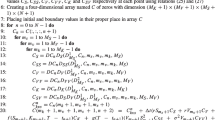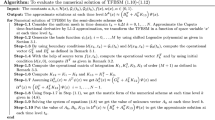Abstract
Recently, stochastic differential equation (SDE) has been used for many applications in option pricing models which satisfy the non-negativity. So, constructing new numerical method preserves non-negativity for solving SDE is very important. This paper investigates the numerical analyses; convergence, non-negativity and stability of the multi-step Milstein method for SDE. We derive the new general s-stage Milstein method; the Lobatto IIIC-Milstein method for nonlinear SDE and show that the numerical solution preserves non-negativity. Moreover, we prove the strong convergence order 1.0 of the numerical method. The unconditional stability results are proven for SDE. In order to get insight into the numerical analysis of the proposed method; the Black–Scholes model is considered to explain that the exact mean square stability region is totally contained in the numerical region (i.e. the numerical method is stochastically A-stable). In addition, the accuracy and computational cost are discussed. Finally, the Lobatto IIIC-Milstein method was compared with existing Milstein type methods, Monte-Carlo and finite difference methods to examine the efficiency of the proposed method to value the price.








Similar content being viewed by others
References
Aghda, A.S.F., Hosseini, S.M., Tahmasebi, M.: Analysis of non-negativity and convergence of solution of the balanced implicit method for the delay coxingersollross model. Appl. Numer. Math. 118(118), 249–265 (2017)
Black, F., Scholes, M.: The pricing of options and corporate liabilities. J. Polit. Econ. 81(3), 637–654 (1973)
Boyle, P.P.: Options: a Monte Carlo approach. J. Financ. Econ. 4(3), 323–338 (1977)
Brennan, M.J., Schwartz, E.S.: Finite difference methods and jump processes arising in the pricing of contingent claims: A synthesis. J. Financ. Quant. Anal. 13(3), 461–474 (1978)
Dangerfield, C.E., Kay, D., Macnamara, S., Burrage, K.: A boundary preserving numerical algorithm for the wright-fisher model with mutation. Bit Numer. Math. 52(2), 283–304 (2012)
Dixit, A.K., Pindyck, R.: Investment Under Uncertainty. Princeton University Press, Princeton (1994)
Ehle, B.L.: On pade approximations to the exponential function and a-stable methods for the numerical solution of initial value problems. Ph.D. thesis, University of Waterloo (1969)
Eissa, M., Eldanaf, T., Ramadan, M.: Numerical Solutions Using Cellular Neural Networks: How to Use Cellular Neural Networks to Approximate Ordinary and Partial Differential Equations? LAP Lambert Academic Publishing (2016). https://books.google.de/books?id=XQchMQAACAAJ
Eissa, M.A.: Mean-square stability of two classes of theta milstein methods for nonlinear stochastic differential equations. In: Proceedings of the Jangjeon Mathematical Society (2019)
Eissa, M.A., Tian, B.: Lobatto–Milstein numerical method in application of uncertainty investment of solar power projects. Energies 10(1), 43 (2017)
Eissa, M.A., Tian, B.: A stochastic corporate claim value model with variable delay. J. Phys. Conf. Ser. 1053, 012018 (2018)
Eissa, M.A., Xiao, Y., Tian, B.: Convergence and stability of two classes of theta methods with variable step size for a stochastic pantograph equations. J. Adv. Math. Appl. 5(2), 95–106 (2016)
Eissa, M.A., Zhang, H., Xiao, Y.: Mean-square stability of split-step theta Milstein methods for stochastic differential equations. Math. Probl. Eng. 2018 (2018)
Fadugba, S., Nwozo, C., Babalola, T.: The comparative study of finite difference method and Monte Carlo method for pricing european option. Math. Theory Model. 2, 60–66 (2012)
Glasserman, P.: Monte Carlo Methods in Financial Engineering, vol. 53. Springer Science & Business Media, New York (2013)
Hairer, E., Nørsett, S., Wanner, G.: Solving ordinary differential equations I: nonstiff problems, vol. 8. Springer Series in Computational Mathematics, Berlin, Heidelberg (1993). https://www.springer.com/gp/book/9783540566700
Hairer, E., Wanner, G.: Solving ordinary differential equations II: stiff and differential-algebraic problems, vol 14. Springer Series in Computational Mathematics, Berlin, Heidelberg (1996). https://www.springer.com/gp/book/9783540604525
Higham, D.J.: A-stability and stochastic mean-square stability. BIT Numer. Math. 40(2), 404–409 (2000)
Higham, D.J.: Mean-square and asymptotic stability of the stochastic theta method. SIAM J. Numer. Anal. 38(3), 753–769 (2000)
Higham, D.J., Mao, X., Stuart, A.M.: Strong convergence of Euler-type methods for nonlinear stochastic differential equations. SIAM J. Numer. Anal. 40(3), 1041–1063 (2002)
Higham, D.J., Mao, X., Stuart, A.M.: Exponential mean-square stability of numerical solutions to stochastic differential equations. LMS J. Comput. Math. 6, 297–313 (2003)
Higham, D.J., Mao, X., Szpruch, L.: Convergence, non-negativity and stability of a new Milstein scheme with applications to finance. Discrete Contin. Dyn. Syst. Ser. B 18(8), 2083–2100 (2013)
Huang, C.: Exponential mean square stability of numerical methods for systems of stochastic differential equations. J. Comput. Appl. Math. 236(16), 4016–4026 (2012)
Jiang, F., Zong, X., Yue, C., Huang, C.: Double-implicit and split two-step Milstein schemes for stochastic differential equations. Int. J. Comput. Math. 93(12), 1987–2011 (2016)
Kahl, C.: Positive numerical integration of stochastic differential equations. Master’s thesis, Diplomarbeit, University of Wuppertal, Wuppertal (2004)
Kahl, C., Schurz, H.: Balanced Milstein methods for ordinary SDEs. Monte Carlo Methods Appl. 12(2), 143–170 (2006)
Larsson, S., Thomée, V.: Partial differential equations with numerical methods, vol. 45. Texts in Applied Mathematics, Springer, Berlin, Heidelberg (2003). https://www.springer.com/gp/book/9783540017721?gclid=EAIaIQobChMItaHur7nm6wIVCvSzCh3tLgH0EAAYASAAEgLA0vD_BwE
Mao, X.: Stochastic Differential Equations and Applications. Elsevier, Amsterdam (2007)
Merton, R.C.: Theory of rational option pricing. Bell J. Econ. Manag. Sci. 4(1), 141–183 (1973)
Merton, R.C.: On the pricing of corporate debt: the risk structure of interest rates. J. Finance 29(2), 449–470 (1974)
Mil’shtejn, G.: Approximate integration of stochastic differential equations. Theory Probab. Appl. 19(3), 557–562 (1975)
Moro, E., Schurz, H.: Boundary preserving semianalytic numerical algorithms for stochastic differential equations. SIAM J. Sci. Comput. 29(4), 1525–1549 (2007)
Ramadan, M., El-Danaf, T.S., Eissa, M.A.: Approximate solutions of partial differential equations using cellular neural networks. Int. J. Sci. Eng. Investig 4, 14–21 (2015)
Ramadan, M., ElDanaf, T.S., Eissa, M.A.: System of ordinary differential equations solving using cellular neural networks. J. Adv. Math. Appl. 3(2), 182–194 (2014)
Saito, Y., Mitsui, T.: Stability analysis of numerical schemes for stochastic differential equations. SIAM J. Numer. Anal. 33(6), 2254–2267 (1996)
Sauer, T.: Numerical Analysis. Pearson, Boston (2005)
Sauer T.: Numerical solution of stochastic differential equations in finance. In: Duan, J.C., Härdle, W., Gentle, J. (eds.) Handbook of Computational Finance. Springer Handbooks of Computational Statistics. Springer, Berlin, Heidelberg (2012). https://doi.org/10.1007/978-3-642-17254-0_19
Schulmerich, M.: Real Options Valuation: The Importance of Interest Rate Modelling in Theory and Practice. Springer Science & Business Media (2010)
Schurz, H.: Numerical regularization for SDEs: construction of nonnegative solutions. Weierstrass-Inst. für Angewandte Analysis und Stochastik (1995)
Sinch, S.: Split-step forward Milstein method for stochastic differential equations. Int. J. Numer. Anal. Model. 9(4), 970–981 (2012)
Sorsimo, A.: Numerical methods in real option analysis. Master’s thesis, Department of Economics Aalto University School of Business (2015)
Thompson, M., Barr, D.: Cut-off grade: a real options analysis. Resour. Policy 42, 83–92 (2014)
Tian, B., Eissa, M.A., Zhang, S.: Two families of theta Milstein methods in a real options framework. In: Proceedings of the 5th Annual International Conference on Computational Mathematics, Computational Geometry and Statistics (CMCGS 2016), Singapore, pp. 18–19 (2016)
Voss, D.A., Khaliq, A.Q.: Split-step Adams–Moulton Milstein methods for systems of stiff stochastic differential equations. Int. J. Comput. Math. 92(5), 995–1011 (2015)
Wang, P., Han, Y.: Split-step backward Milstein methods for stiff stochastic systems. J. Jilin Univ. (Science Edition) 47(6), 52–56 (2009)
Wilmott, P.: Paul Wilmott on Quantitative Finance. Wiley, New York (2013)
Xiao, Y., Eissa, M.A., Tian, B.: Convergence and stability of split-step theta methods with variable step-size for stochastic pantograph differential equations. Int. J. Comput. Math. 95(5), 939–960 (2018)
Zhu, Q., Wang, H.: Output feedback stabilization of stochastic feedforward systems with unknown control coefficients and unknown output function. Automatica 87, 166–175 (2018)
Zhu, Q., Zhang, Q.: pth moment exponential stabilisation of hybrid stochastic differential equations by feedback controls based on discrete-time state observations with a time delay. IET Control Theory Appl. 11(12), 1992–2003 (2017)
Zong, X., Wu, F.: Choice of \(\theta\) and mean-square exponential stability in the stochastic theta method of stochastic differential equations. J. Comput. Appl. Math. 255, 837–847 (2014)
Zong, X., Wu, F., Huang, C.: Preserving exponential mean square stability and decay rates in two classes of theta approximations of stochastic differential equations. J. Differ. Equ. Appl. 20(7), 1091–1111 (2014)
Zong, X., Wu, F., Xu, G.: Convergence and stability of two classes of theta-Milstein schemes for stochastic differential equations (2015). arXiv:1501.03695
Acknowledgements
The authors are grateful to Dr. Zhanwen Yang for helpful discussions and suggestions. Furthermore, we thank the anonymous editor and reviewers for careful reading and many helpful suggestions to improve the presentation of this paper. This research was partly financed by NSFC Grant Number: 71532004 and 71850013.
Author information
Authors and Affiliations
Corresponding author
Ethics declarations
Conflict of interest
The authors declare that they have no competing interests.
Additional information
Publisher's Note
Springer Nature remains neutral with regard to jurisdictional claims in published maps and institutional affiliations.
Background of the Lobatto IIIC methods
Background of the Lobatto IIIC methods
The fundamental analysis contain convergence and stability for numerical methods for differential equations are provided in [8, 12, 16, 17, 33, 34]. The families of Runge–Kutta (RK) methods based on Lobatto quadrature formulas are one of several classes of fully implicit RK methods possessing good stability properties for ODE. The number III is usually found in the literature associated to Lobatto methods. Ehle [7] introduced Lobatto IIIA, IIIB, IIIC classes, and the general definition of the Lobatto IIIC methods. For more information about the fundamental properties of Lobatto methods, we recommend [16, 17].
The classes of s-stage Lobatto methods are given in [17]
where the stage value s satisfies \(s\ge 2\) and the coefficients \(a_{ij},b_j\) and \(c_j\) characterized the Lobatto methods. The s intermediate values \(Y_{nj}\) for \(j=1,\ldots ,s\) are called the internal stages and can be considered as approximations to the solution at \(t_n+c_jh\). The main numerical approximation at \(t_{n+1} = t_n+h\) is given by \(y_{n+1}\). Lobatto methods are characterized by \(c_1=0\) and \(c_s=1\). For a fixed value of s the various families of Lobatto methods share the same coefficients \(b_j\) and \(c_j\). In addition, the coefficients \(a_{ij}\) are vary depending on the classes of Lobatto methods. For Lobatto IIIC class, the \(a_{ij}\) defined as
and determined the remaining \(a_{ij}\) by \(C(s-1)\). The coefficients of the Lobatto IIIC methods can be displayed by the Butcher-tabelau in Table 7.
The stability properties of numerical methods for deterministic ODE are reported in [17]. In the following, we present the well-known results for Lobatto methods in a way that helps to motivate the SDE analysis.
Proposition 1
(see [17]) The s-stage Lobatto IIIC methods (87–88) applied to the scalar test equation
where \(\lambda \in \mathbb {C}\) is a constant, yields
with
where \(b^T=(b_1,\ldots ,b_s)\), \(A=(a_{ij})^s_{i,j=1}\), \(\mathbf {1}=(1,\ldots ,1)^T\), and I is the identity matrix. R(Z) is called the stability function of the numerical method, which can be written for implicit methods as rational function with numerator and demonstrator of degree \(\le s\) as follows
Let \(S_L\) is the stability domain for the Lobatto IIIC methods (87–88), Then the method with stability function (93) is A-stable if and only if \(|R(iy)|\le 1\) for all real y and R(Z) is analytic for \(Re Z<0\). In addition, using the definition of the method coefficients (89), and (Proposition 3.8 in [17]), we find that the method also is L-stable. Furthermore, the Lobatto IIIC methods are characterized by non-stiff order \((2s-2)\), not symmetric, algebraically stable, B-stable, and the stability function R(z) is given by \((s-2,s)\) Padé approximation to \(e^z\). So, the the Lobatto IIIC methods (87–88) are described as excellent methods for stiff problems.
About this article
Cite this article
Eissa, M.A., Ye, Q. Convergence, non-negativity and stability of a new Lobatto IIIC-Milstein method for a pricing option approach based on stochastic volatility model. Japan J. Indust. Appl. Math. 38, 391–424 (2021). https://doi.org/10.1007/s13160-020-00443-x
Received:
Revised:
Accepted:
Published:
Issue Date:
DOI: https://doi.org/10.1007/s13160-020-00443-x
Keywords
- Stochastic differential equations
- Black–Scholes model
- Milstein methods
- Convergence
- Non-negativity
- Stability




